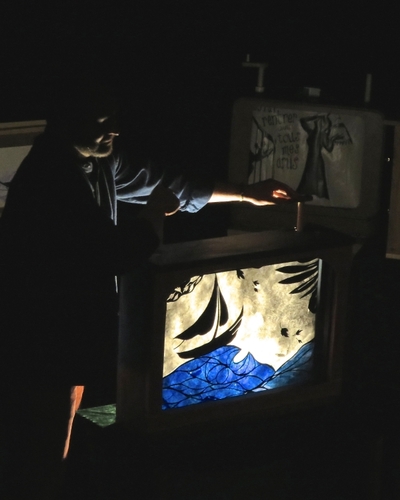PUTNEY — When Brendan Taaffe first saw one, he thought it was magical.
When he saw one for the second time, he still found it wondrous, but also figured that he could make one.
Thus began Taaffe's love affair with crankies.
“A crankie is an old storytelling art form,” writes Sue Truman at her website dedicated to the art of crankies: www.thecrankiefactory.com. “It's a long, illustrated scroll that is wound onto two spools. The spools are loaded into a box which has a viewing screen. The scroll is hand-cranked while the story is told. It can be accompanied by a narrative, song, or tune.”
Truman is one of the artists who will be appearing at the Fourth Annual Vermont Crankie Fest at 7:30 p.m., on Saturday, Jan. 13, at the New England Youth Theatre at 100 Flat St. in Brattleboro.
Conceived to celebrate the magic and diversity of crankies, this festival brings together a vibrant collection of artists from far and wide presenting their work, accompanying Scottish stories, original poems, Appalachian ballads, and even a barn quilt trail.
The festival is the brainchild of Brendan Taaffe, a multi-instrumentalist, composer, and visual artist who recently bought an old farmhouse in Vernon. He performs and teaches throughout the U.S. and Europe as a solo artist and with ensembles including The Waxwing Four, The New Line, and the Bright Wings Chorus.
His paper-cut crankie “Man of Double Deed” was part of the 2017 exhibit Banners and Cranks at the Ballard Institute and Museum of Puppetry in Storrs, Conn.
Joining Taaffe at the Fourth Annual Vermont Crankie Fest will be several illustrious crankie artists.
The Crankie Factory
Sue Truman is so passionate about the history of crankies that she created the website The Crankie Factory. Truman is a fiddler, guitarist, and crankie artist from Seattle, Wash., who has been creating crankies since 2011. She works primarily with fabric, felt, and lace but also creates crankie scrolls from “paper cut” images.
A member of the International Panorama Council, Truman has traveled to Europe to present at conferences, and contributed the article Crankies: Recreating the Moving Panorama as Contemporary Folk Art, to a Council book of articles to be published in 2018.
Ellen Gozion, from Pittsburgh, is a well-regarded singer of traditional American and British Isles ballads who performs as a soloist with folk and old-time musicians and over the years has appeared with the period ensemble Chatham Baroque.
Gozion began making crankies in 2011 and is the founder and producer of the Pittsburgh Crankie Fest. Her paper mosaic crankie “Pretty Fair Miss” was part of the 2017 exhibit at the Ballard Institute and Museum of Puppetry.
These performers will be joined by Mary Lauren Fraser and Kiah Raymond, two young artists from Western Massachusetts and Maine who make crankies together, with a particular interest in the stories and music of the Scottish Islands and Highlands.
But there is more to the Vermont Crankie Fest than its evening concert.
At 3 p.m., on the afternoon of the festival, a community crankie-making workshop will give everyone a chance to work on one giant crankie for Si Kahn's classic song, “Here is My Home.”
At the end of the evening performance, local legend Tony Barrand will lead the audience in this song, which reflects on what we value about our community, while the group crankie is performed. Suggested donation for the community workshop is $5-20.
“The term crankie is being used now to name this very old art form,” Truman writes at her website. “In the 19th century, they were called moving panoramas among many other names.”
In the 1800s, moving panoramas were a popular entertainment and were often much larger than today's crankies.
“For instance, there was even a huge panorama of Pilgrim's Progress that was 200 feet long and told John Bunyan's entire book,” Taaffe says. “Some panoramas depict historical events like famous battle scenes, such as one in the statehouse in Tennessee. Others were used as backdrops for old silent movies.”
Modern revival
After the 1800s, moving panoramas fell out of favor. The modern revival of crankies began when Peter Schumann of Bread and Puppet Theater, now located in Glover, Vermont, began making them in the late 1960s.
“It was Schumann who came up with the name 'crankie,'” Taaffe says. “He revitalized the form, but only in the last decade or so has the crankie phenomenon really taken off, now with festivals all across the country in cities like Seattle, Pittsburgh, and Baltimore.”
Taaffe believes a crankie can be appreciated on many levels.
“It's a way to conceive of the stories in ballads,” he says. “I have a background in traditional Irish music and play ballads on fiddle, banjo, and guitar. Like so many others, I discovered the power of crankies when I saw someone else use one. As a listener, audiences become active and committed to the words being sung when watching a crankie.
“To see the scrolling image pulls you into the song with less processing than just listening [in a way] that is so amazing. Illustrating stories both figuratively and literally, crankies can combine traditional musicians, puppetry, and alternative theater in interesting ways.”
Taaffe's crankies usually are 18 by 24 inches.
“They're little wooden puppet theaters with an illustrated scroll turning from one side to another to accompany my song,” he says. “Mine are back-lit, with paper cutouts, evocative of Shadow Puppet theater. But crankies come in an amazing amount of styles. ”
Taaffe, who performs with his crankies in solo shows, in schools, and during breaks at contra dances, finds himself constantly surprised at how dissimilar from one another crankies - a fundamentally limited medium - can be.
“People are able to get to incredibly different places in creating their crankies,” he says. “The variety and flexibility of crankies are remarkable.”
